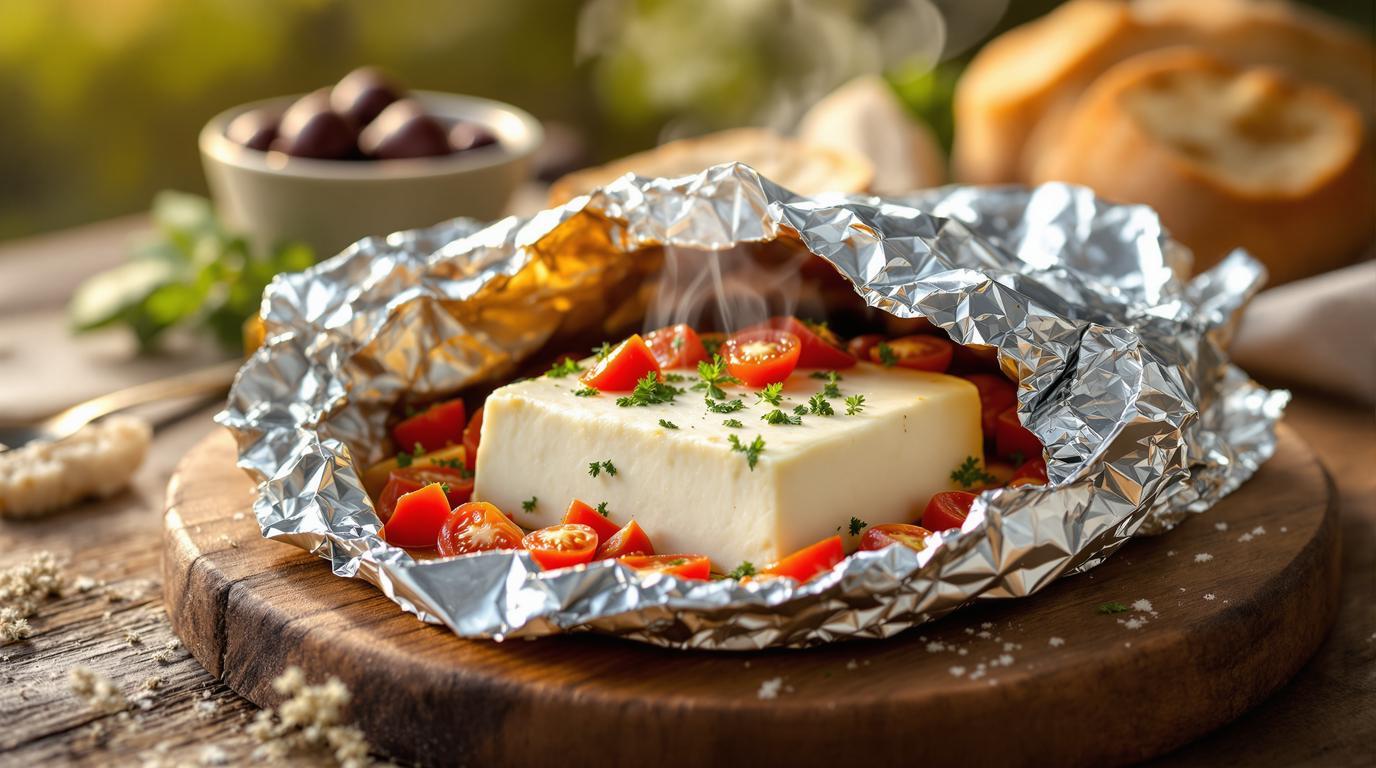There’s something magical about the way cheese transforms when exposed to heat. In my early days working in a small taverna outside Athens, I learned that the simplest preparations often create the most profound flavor experiences. Grilled feta with tomatoes—or “Psiti Feta me Domata” as the locals called it—was my introduction to the beautiful minimalism of authentic Greek cuisine. It taught me that when ingredients are exceptional, you need very little else.
🧀 The Perfect Two-Ingredient Wonder
Traditional Greek tavernas have perfected the art of creating extraordinary dishes from just a handful of ingredients. This grilled feta requires only two star players—a perfect block of brined feta and ripe, juicy tomatoes—elevated by a few pantry staples. The magic happens in the gentle melting of the cheese, which transforms from crumbly to creamy while absorbing the sweet juices of the tomatoes.
Years ago, while visiting a small fishing village, I watched as an elderly woman prepared this dish using feta from her neighbor’s goats and tomatoes still warm from her garden. The simplicity stunned me, but the flavor was unforgettable.
🍅 Essential Ingredients
- 1-inch thick slice (200g) high-quality feta cheese (must be block-style, not pre-crumbled)
- 1 small ripe tomato (about 150g), diced into small cubes
- 1 tablespoon (15ml) extra virgin olive oil
- 1 teaspoon dried Greek oregano
- Freshly ground black pepper (optional)
Chef’s Note: The quality of the feta makes all the difference here. Look for authentic Greek feta made from sheep’s milk or a sheep and goat milk blend. It should be stored in brine, not pre-packaged in dry crumbles. The creamy texture and tangy flavor are essential to this dish’s success.
🔥 Step-by-Step Instructions
- Prepare your station: Tear a piece of heavy-duty aluminum foil about 12 inches (30cm) square. If using a grill, preheat to medium-low (around 350°F/180°C).
- Prepare the feta: Place your slice of feta in the center of the foil. Use your fingertips to create a few small dimples in the top surface.
- Add tomatoes: Scatter the diced tomatoes evenly over and around the feta.
- Season: Drizzle with olive oil and sprinkle with the dried oregano. Add a light grinding of black pepper if desired.
- Create a packet: Fold the foil up and over the cheese to create a sealed packet, leaving some airspace above the cheese for steam to collect.
- Cook: Place the packet on the grill (or in a 350°F/180°C oven) and cook for 10-15 minutes, until the cheese has softened but not completely melted. The feta should yield easily when pressed but still maintain its shape.
👨🍳 Chef’s Secret Techniques
The key to this dish is temperature control. Feta doesn’t melt like mozzarella; it softens while maintaining its integrity. If you heat it too quickly or at too high a temperature, it can become tough and rubbery. Gentle heat allows the cheese to warm through without losing its creamy texture.
I’ve discovered that creating a few small indentations in the top of the feta before cooking helps the tomato juices pool and infuse the cheese with flavor. This technique—similar to what we use for our zero-waste cooking approaches—ensures no delicious tomato essence escapes.
🍽️ Serving & Presentation
To serve this dish the traditional way, place the entire foil packet on a heat-resistant platter and open it at the table, allowing the aromatic steam to escape before your guests’ eyes. The visual and sensory experience enhances appreciation of this humble dish.
Accompany with warm, crusty bread for dipping into the molten cheese mixture. For a complete meal, pair with a grilled watermelon and feta salad or serve alongside grilled fish or lamb.
For wine pairing, a crisp Assyrtiko from Santorini offers the perfect complement, with its minerality and citrus notes balancing the richness of the cheese.
🌿 Thoughtful Variations
While I believe in mastering the classic version first, this dish welcomes gentle adaptation. Some island variations include a drizzle of honey before serving for a sweet contrast with the salty cheese. Others add a pinch of chili flakes for heat.
If tomatoes aren’t at their peak, roasted red peppers make an excellent substitute, offering sweetness and a smoky flavor that complements the feta beautifully. You can also enhance the flavors with techniques similar to those used in traditional marinades by adding a splash of lemon juice before cooking.
For the perfect texture contrast, consider serving with crispy potatoes—the combination of creamy cheese and crunchy potatoes is divine. And if you’re feeling adventurous, try adding a pinch of salt to echo the technique used in Vietnamese coffee, which enhances flavors in surprising ways.
This simple preparation reminds us that extraordinary culinary experiences don’t require complicated techniques or rare ingredients—just respect for tradition and attention to quality. In my years of professional cooking, I’ve rarely found a dish that offers such profound satisfaction with so little effort.
